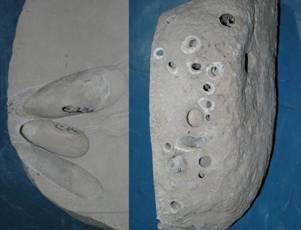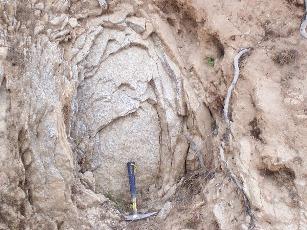Physical weathering
Biological activity. Lithofagus from Mejillones, Chile
Image Credit: MBG
Thermal expansion and contraction: Spheroidal weathering in granite. La Serena, Chile.
Image Credit: MBG
Rocks and minerals are fragmented by mechanical processes. There is no change of their chemical composition. Physical weathering transforms a large mass of rock into smaller pieces which are more easily transported and eroded.
Rocks can break for a variety of reasons, including stress along natural zones of weakness and due to biological and chemical activity.
a) Natural zones of weakness: Even massive rocks tends to crack along natural zones of weakness. Some of the most common are bedding planes in sedimentary rocks, exfoliation in metamorphic rocks and joints in massive igneous rocks. Through uplift and erosion, rock rise slowly to the Earth’s surface, where they are free from the weight of overlying rock; thus, their fractures will open slightly. This allows chemical and physical weathering to widen the cracks.
b) Biological Activity: Living organism may influence chemical and physical weathering. Activity of organisms that occupy cracks produce acids, which then promotes chemical weathering, and the growth of microcracks. The force of the growing root system may also assist in opening cracks and fractures.
c) Mineral crystallization:The crystallization of salts from solution in rock fractures may apply a force that can split rocks.
d) Thermal expansion and contraction: Daily cycles of hot days and cold nights in desert areas can contribute to rock breaking because different minerals possess disfferent themral expansion coefficients.
e) Exfoliation and spheroidal weathering: These are not directly related to earlier fractures or joints caused by previous weathering. Exfoliation is a process in which large flat or curved sheets of rock fracture and are detached from the outcrop due to pressure release: As erosion removes the overburden from a rock that formed at high pressure deep in the Earth´s crust, it allows the rock to expand, thus resulting in cracks and fractures along sheet joints parallel to the erosion surface.
Spheroidal weathering is also a process of cracking and splitting off of curved layers from a generally spherical boulder, but on a much smaller scale. It occurs when a rectangular block is weathered from three sides at the corners and from two sides along its edges. It is also called “onion skin” weathering and is closely related to chemical weathering.
f) Hydraulic action:At rocky shores, air in a fracture can suddenly be compressed by a wave closing the entrance of the fracture. This compressive force can widen the fracture.

